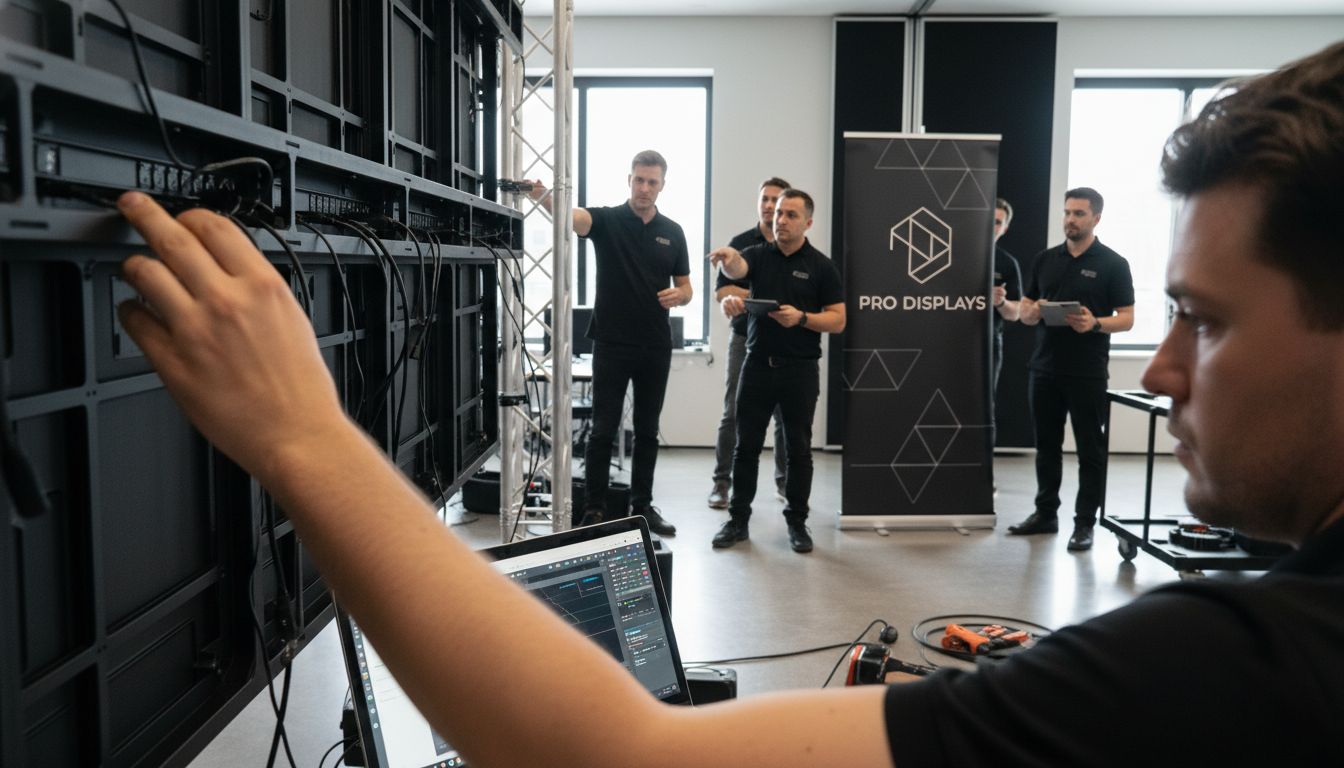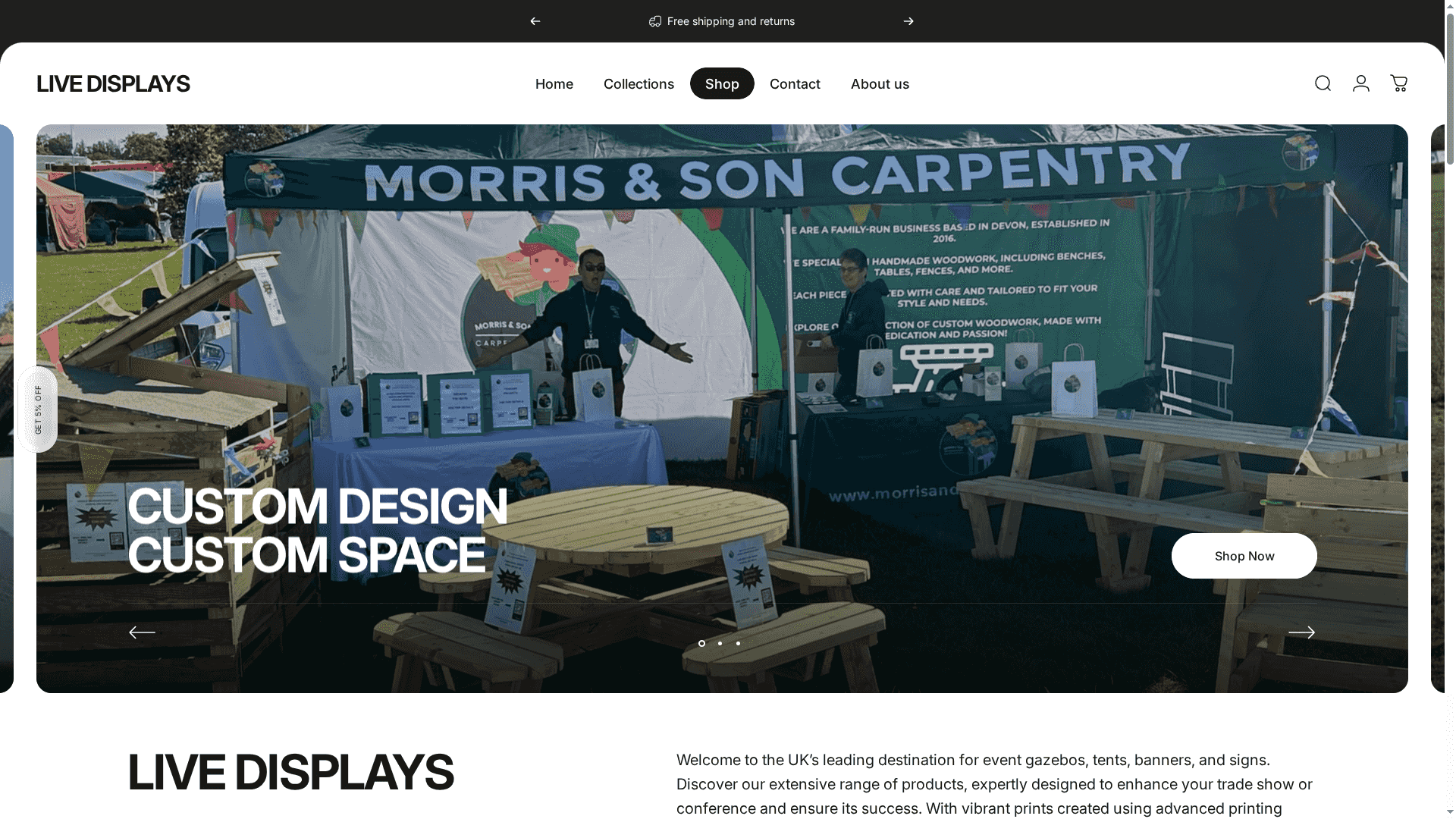Over 80 percent of event organisers say that display technology has transformed how they engage audiences. In today’s fast-paced event scene, the right visual tools are more than just accessories—they are central to capturing attention and delivering clear messages. Whether you are managing a small meeting or a large-scale conference, understanding modern display options equips you to make choices that create lasting impact and elevate every presentation.
Table of Contents
- Definition And Fundamentals Of Display Technology
- Types Of Display Solutions For Events
- How Modern Display Technology Works
- Applications In Events And Trade Shows
- Key Factors In Selecting Display Technology
- Common Pitfalls And Best Practices
Key Takeaways
| Point | Details |
|---|---|
| Understanding Display Technology | Familiarize with types of display technology such as LCD, OLED, DLP, and PDP to select the appropriate solution for presentations. |
| Selecting Display Solutions | Consider factors like event size, venue environment, and audience distance when choosing display solutions for effective communication. |
| Strategic Planning is Essential | Anticipate potential pitfalls by conducting thorough venue assessments and technical rehearsals to ensure smooth execution. |
| Utilizing Portable Options | Portable displays, such as roll-up banners, provide flexibility and ease of use, making them ideal for various event settings. |
Definition and Fundamentals of Display Technology
Display technology represents the visual interface that transforms digital signals into viewable images, enabling businesses and event organisers to communicate complex information through visual mediums. At its core, display technology encompasses electronic systems designed to present visual content across various platforms and devices.
According to research from iie.edu.in, display technologies can be categorised into several primary types, each with unique operational characteristics:
- Liquid Crystal Displays (LCD): Utilise liquid crystal molecules that manipulate light to create images
- Organic Light Emitting Diodes (OLED): Generate light through organic compounds, enabling superior colour reproduction
- Digital Light Processing (DLP): Employ microscopic mirrors to reflect light and create digital images
- Plasma Display Panels (PDP): Use ionised gas cells to produce visual content
Each display technology offers distinct advantages depending on specific event requirements. Resolution, contrast ratios, and colour accuracy are critical factors event professionals must consider when selecting appropriate display solutions. Dot-matrix displays, for instance, provide cost-effective options for simple text and graphic presentations in scenarios like conference schedules or basic informational signage.
Understanding display technologies empowers event organisers to make strategic visual communication decisions. The right display can transform audience engagement, turning standard presentations into memorable experiences that capture attention and convey information effectively.
Types of Display Solutions for Events
Event display solutions have evolved dramatically, offering organisations a wide range of visual communication tools tailored to specific presentation needs. From compact displays for intimate meetings to expansive screens for large conferences, modern display technologies provide unprecedented flexibility and impact.
According to Hayamim, event professionals can choose from several strategic display options:
- All-in-One LED Displays: Perfect for meeting rooms and boardrooms, offering integrated functionality
- Modular LED Displays: Ideal for large-scale indoor events with customisable dimensions
- Roll-Up Banner Displays: Portable and quick to deploy for trade shows and exhibitions
- Projection Screens: Versatile options for detailed visual presentations
Each display solution offers unique advantages based on event scale, audience size, and communication objectives.
 Portable displays like roll-up banners provide exceptional convenience, while large-format LED screens can transform conference environments by delivering high-impact visual experiences.
Portable displays like roll-up banners provide exceptional convenience, while large-format LED screens can transform conference environments by delivering high-impact visual experiences.
Choosing the right display solution requires careful consideration of factors such as venue constraints, audience size, content complexity, and budget.
 Aluminium roll up displays offer event organisers a lightweight, professional solution that combines portability with visual sophistication, ensuring your message is communicated effectively in any event setting.
Aluminium roll up displays offer event organisers a lightweight, professional solution that combines portability with visual sophistication, ensuring your message is communicated effectively in any event setting.
How Modern Display Technology Works
Modern display technology represents a sophisticated intersection of physics, electronics, and visual engineering, transforming digital signals into vibrant visual experiences. At its core, these technologies convert electrical inputs into precise light emissions, creating images through complex yet elegant mechanisms that manipulate light at microscopic levels.
According to research on quantum dot displays, advanced display technologies now utilize semiconductor nanocrystals capable of producing pure monochromatic red, green, and blue light. This breakthrough enables unprecedented color accuracy and reproduction, allowing displays to generate incredibly nuanced and lifelike visual representations.
Some remarkable display technologies demonstrate extraordinary operational principles:
- Quantum Dot Displays: Use nanocrystals to generate precise color wavelengths
- Laser-Powered Phosphor Displays: Employ ultra-violet laser beams to activate phosphor-coated screens
- LED Technologies: Manipulate semiconductor materials to produce light emissions
- OLED Panels: Create images through organic light-emitting compounds
Laser-powered phosphor displays offer a fascinating example of technological innovation, using movable mirrors to direct laser beams line by line across phosphor-coated screens. This method allows for creating large, energy-efficient displays with remarkable image quality and minimal power consumption.
Understanding these technological mechanisms empowers event professionals to select display solutions that not only look impressive but also deliver optimal visual performance tailored to specific presentation requirements.
Applications in Events and Trade Shows
Display technologies have revolutionised event experiences, transforming how organisations communicate and engage with audiences across various professional settings. From trade show exhibitions to corporate presentations, modern display solutions offer unprecedented opportunities for visual storytelling and interactive communication.
TWL LED Display research highlights how LED screens can dramatically transform event venues, turning traditional spaces into dynamic visual environments. These high-definition displays serve multiple critical functions in professional events:
- Stage Backdrops: Replace static backgrounds with customizable digital scenery
- Information Display: Provide real-time updates and schedule information
- Branding Platforms: Showcase company logos and marketing messages
- Interactive Engagement: Create immersive visual experiences
Rocket Alumni Solutions demonstrates the potential of interactive display technologies, showcasing how touchscreen interfaces can enhance audience participation. These advanced systems enable real-time information updates, allowing event organisers to create personalised, engaging experiences that capture and maintain attendee attention.
For trade shows and conferences, display technologies are no longer just visual tools but strategic communication platforms. Trade show roll up banner stands exemplify how portable, sophisticated display solutions can transform modest spaces into compelling brand narratives, ensuring maximum visual impact with minimal logistical complexity.
Key Factors in Selecting Display Technology
Selecting the appropriate display technology is a critical decision that can significantly impact an event’s visual communication effectiveness. Event professionals must navigate a complex landscape of technological options, balancing technical specifications with practical considerations to achieve optimal audience engagement.
Hayamim provides comprehensive guidance on choosing the right display technology, highlighting several crucial selection factors:
- Event Size: Determining appropriate screen dimensions and resolution
- Venue Environment: Assessing indoor or outdoor display requirements
- Audience Distance: Calculating optimal viewing angles and screen placement
- Content Complexity: Matching display capabilities with presentation needs
- Budget Constraints: Balancing technical performance with financial limitations
The selection process requires a strategic approach that considers multiple interconnected variables. Display resolution, brightness levels, and compatibility with existing technical infrastructure become paramount when making these technological choices. Factors like pixel pitch, contrast ratio, and refresh rate can dramatically influence visual performance.
For event organisers seeking practical solutions, portable pull up banner stands represent an excellent compromise between sophisticated visual communication and logistical flexibility. These versatile display solutions demonstrate how modern technology can deliver high-impact presentations without complex technical requirements, offering event professionals adaptable visual communication tools that meet diverse presentation needs.
Common Pitfalls and Best Practices
Navigating display technology requires strategic planning and awareness of potential challenges that can undermine event presentation effectiveness. Event professionals must anticipate and mitigate risks to ensure seamless visual communication and audience engagement.
Hayamim highlights critical pitfalls event organisers frequently encounter with display technologies:
- Venue Constraint Oversight: Failing to assess physical space limitations
- Inadequate Setup Time: Underestimating technical preparation requirements
- Content Incompatibility: Selecting displays misaligned with presentation materials
- Technical Infrastructure Gaps: Neglecting connectivity and power requirements
- Budget Miscalculation: Choosing technology beyond financial capabilities
Successful display technology deployment demands meticulous pre-event planning and technical rehearsal. Professionals should conduct comprehensive venue assessments, test content compatibility, and perform multiple technical run-throughs to identify potential issues before the actual event.
Roll Up Banner Stands offer a practical solution for event professionals seeking reliable, low-risk display options. These versatile tools demonstrate how strategic technology selection can mitigate common display challenges, providing portable, user-friendly alternatives that reduce technical complexity while maintaining high visual standards.
Elevate Your Event with the Perfect Display Solution
Understanding the challenges of choosing the right display technology for your event can feel overwhelming. You want vibrant colours, sharp resolutions, and reliable equipment without the hassle of complex setups or unexpected technical issues. Whether you’re organising a trade show, conference, or corporate presentation, selecting displays that balance visual impact with practical logistics is key to making your message unforgettable.
At Live Displays, we specialise in helping you overcome these obstacles by offering high-quality, customisable display products designed to capture attention and simplify your event preparation. From portable pull up banner stands to sophisticated aluminium roll up displays, our range ensures your visuals remain sharp and engaging no matter the venue or audience size.

Ready to transform your event experience with the right display technology that fits your goals and budget? Explore our selection today and take advantage of seamless customisation, free artwork proofs, and expert support to bring your vision to life. Visit Live Displays now and start creating a lasting impression with every presentation.
Frequently Asked Questions
What are the different types of display technologies available for events?
Display technologies include Liquid Crystal Displays (LCD), Organic Light Emitting Diodes (OLED), Digital Light Processing (DLP), and Plasma Display Panels (PDP). Each type offers unique operational characteristics and advantages depending on the event requirements.
How do I choose the right display solution for my event?
When selecting a display solution, consider factors such as event size, audience distance, content complexity, venue environment, and budget constraints. Each factor influences the effectiveness of visual communication during the event.
What are the advantages of using LED displays for events?
LED displays offer high brightness, superior color accuracy, and can be configured in various sizes and formats. They serve multiple functions, including stage backdrops, information displays, and interactive engagement platforms, making them versatile for different presentation needs.
What common pitfalls should I avoid when using display technology at events?
Common pitfalls include overlooking venue constraints, inadequate setup time, content incompatibility, technical infrastructure gaps, and budget miscalculations. Thorough pre-event planning and technical rehearsals can help mitigate these risks.

Share:
7 Key Types of Trade Show Banners Every Exhibitor Should Know
Event Signage: Everything You Need to Know